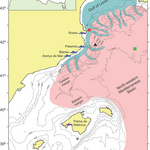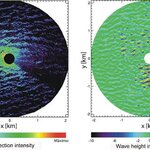Oceanography

The rise of oxygen and the oxidation of deep oceans between 635 and 551 million years ago had an impact on the increase and spread of the earliest complex life, including animals, according to a study in PNAS.
The atmosphere had almost no oxygen until 2.5 billion years ago and it was not until about 600 million years ago that the atmospheric oxygen level rose to a fraction of modern levels. Geologists and evolutionary biologists have speculated that the rise of the breathing gas and subsequent oxygenation of the deep oceans are intimately tied to the evolution of modern biological systems.…

Scientists from Commonwealth Scientific and Industrial Research Organisation (CSIRO) and Woods Hole Oceanographic Institution (WHOI)aboard the research vessel Southern Surveyor returned home today with a collection of coral samples and photographs taken in the Southern Ocean at greater depths than ever before.
Using a remotely operated submersible vehicle the international research team captured images of life found on deep-sea pinnacles and valleys up to three kilometres beneath the Ocean’s surface.
During a three-week voyage, scientists from CSIRO’s Wealth from Oceans National Research…

Ice loss in Antarctica increased by 75 percent in the last 10 years due to a speed-up in the flow of its glaciers and is now nearly as great as that observed in Greenland, according to a new, comprehensive study by UC Irvine and NASA scientists.
In a first-of-its-kind study, an international team led by Eric Rignot, professor of Earth system science at UCI and a scientist with NASA’s Jet Propulsion Laboratory, Pasadena, Calif., estimated changes in Antarctica’s ice mass between 1996 and 2006 and mapped patterns of ice loss on a glacier-by-glacier basis. They detected a sharp jump in…

In an PLoS ONE article, Joan B. Company and colleagues at the Institut de Ciències del Mar (CSIC) in Spain describe a mechanism of interaction across ecosystems showing how a climate-driven phenomenon originated in shelf environments controls the biological processes of a deep-sea living resource.
The progressive depletion of world fisheries is one of the key socio-economical issues of the forthcoming century. However, amid this worrying scenario, Company’s study demonstrates how a climate-induced phenomenon occurring at a decadal time-scale, such as the formation of dense shelf waters and…

Increasing amounts of ice mass have been lost from West Antarctica and the Antarctic peninsula over the past ten years, according to research from the University of Bristol and published online this week in Nature Geoscience.
Meanwhile the ice mass in East Antarctica has been roughly stable, with neither loss nor accumulation over the past decade.
Professor Jonathan Bamber at the University of Bristol and colleagues estimated the flux of ice from the ice sheet into the ocean from satellite data that cover 85% of Antarctica's coastline, which they compared with simulations of snow…

The last fish you ate probably came from the Bering Sea. At present, the Bering Sea provides roughly half the fish caught in U.S. waters each year and nearly a third caught worldwide.
While the basic dynamics of a 'greenhouse ocean' are not well understood, marine ecologists writing in Marine Ecology Progress Series expressed concern that, if their predictions are true, a warming ocean would lead to a much different ecology there.
“All the fish that ends up in McDonald’s, fish sandwiches — that’s all Bering Sea fish,” said USC marine ecologist Dave Hutchins. “The experiments we did up there…

A new study by University of Colorado at Boulder researchers indicates older, multi-year sea ice in the Arctic is giving way to younger, thinner ice, making it more susceptible to record summer sea-ice lows like the one that occurred in 2007.
The team used satellite data going back to 1982 to reconstruct past Arctic sea ice conditions, concluding there has been a nearly complete loss of the oldest, thickest ice and that 58 percent of the remaining perennial ice is thin and only 2-to-3 years old, said the lead study author, Research Professor James Maslanik of CU-Boulder's Colorado Center for…

A Duke University-led analysis of available records shows that while the North Atlantic Ocean’s surface waters warmed in the 50 years between 1950 and 2000, the change was not uniform. In fact, the subpolar regions cooled at the same time that subtropical and tropical waters warmed.
This striking pattern can be explained largely by the influence of a natural and cyclical wind circulation pattern called the North Atlantic Oscillation (NAO), wrote authors of a study published Thursday, Jan. 3, in Science Express.
Winds that power the NAO are driven by atmospheric pressure differences between…

New research published in Quaternary Science Reviews says the collapse of the North American (Laurentide) Ice Sheet caused the flood believed to be behind the "Noah's Ark" story 8000 years ago that kick-started modern European agriculture.
The results indicate a catastrophic rise in global sea level led to the flooding of the Black Sea and drove dramatic social change across Europe. The research team argues that, in the face of rising sea levels driven by contemporary climate change, we can learn important lessons from the past.
The collapse of the Laurentide Ice Sheet released a deluge of…

Giant waves, also known as monster waves, have been talked about by sailors for centuries, often related to unexplained disappearances at sea, but no one quite believed them.
They have been considered merely a myth until recently, when new studies using technological developments like buoys, radars and satellites have scientifically proven the existence of rogue waves, and that they exist in much higher numbers than it was ever expected.
These rogue waves could be the cause of tragic accidents at sea, not only because of their immense power and heights that reach over 30 meters, but it is…